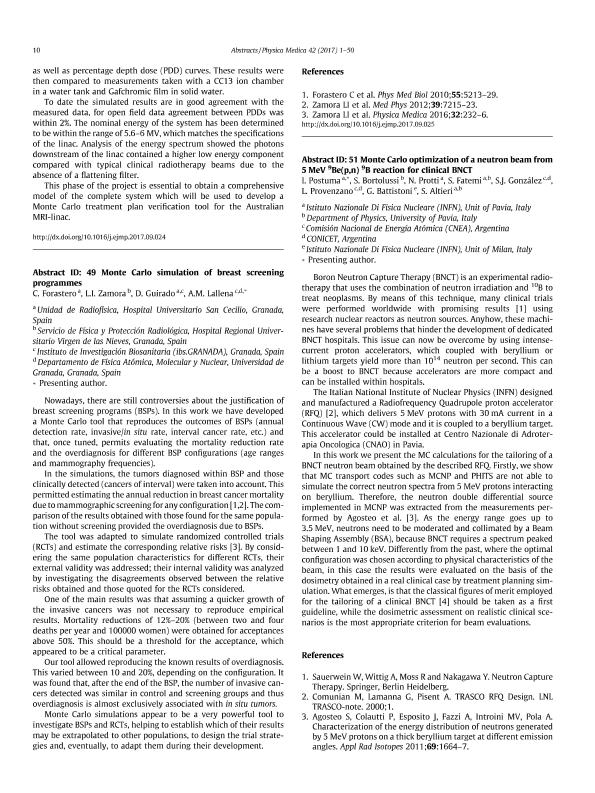Mostrar el registro sencillo del ítem
dc.contributor.author
Postuma, I.
dc.contributor.author
Bortolussi, S.
dc.contributor.author
Protti, N.
dc.contributor.author
Fatemi, S.
dc.contributor.author
González, Sara Josefina

dc.contributor.author
Provenzano, Lucas

dc.contributor.author
Battistoni, G.
dc.contributor.author
Altieri, S.
dc.date.available
2019-03-20T18:22:55Z
dc.date.issued
2017-10
dc.identifier.citation
Postuma, I.; Bortolussi, S.; Protti, N.; Fatemi, S.; González, Sara Josefina; et al.; Abstract ID: 51 Monte Carlo optimization of a neutron beam from 5 MeV 9 Be(p,n) 9 B reaction for clinical BNCT; Istituti Editoriali e Poligrafici Internazionali; Physica Medica; 42; 10-2017; 10-11
dc.identifier.issn
1120-1797
dc.identifier.uri
http://hdl.handle.net/11336/72119
dc.description.abstract
Boron Neutron Capture Therapy (BNCT) is an experimental radiotherapy that uses the combination of neutron irradiation and 10B to treat neoplasms. By means of this technique, many clinical trials were performed worldwide with promising results [1] using research nuclear reactors as neutron sources. Anyhow, these machines have several problems that hinder the development of dedicated BNCT hospitals. This issue can now be overcome by using intense-current proton accelerators, which coupled with beryllium or lithium targets yield more than 1014 neutron per second. This can be a boost to BNCT because accelerators are more compact and can be installed within hospitals.The Italian National Institute of Nuclear Physics (INFN) designed and manufactured a Radiofrequency Quadrupole proton accelerator (RFQ) [2], which delivers 5 MeV protons with 30 mA current in a Continuous Wave (CW) mode and it is coupled to a beryllium target. This accelerator could be installed at Centro Nazionale di Adroterapia Oncologica (CNAO) in Pavia.In this work we present the MC calculations for the tailoring of a BNCT neutron beam obtained by the described RFQ. Firstly, we show that MC transport codes such as MCNP and PHITS are not able to simulate the correct neutron spectra from 5 MeV protons interacting on beryllium. Therefore, the neutron double differential source implemented in MCNP was extracted from the measurements performed by Agosteo et al. [3]. As the energy range goes up to 3.5 MeV, neutrons need to be moderated and collimated by a Beam Shaping Assembly (BSA), because BNCT requires a spectrum peaked between 1 and 10 keV. Differently from the past, where the optimal configuration was chosen according to physical characteristics of the beam, in this case the results were evaluated on the basis of the dosimetry obtained in a real clinical case by treatment planning simulation. What emerges, is that the classical figures of merit employed for the tailoring of a clinical BNCT [4] should be taken as a first guideline, while the dosimetric assessment on realistic clinical scenarios is the most appropriate criterion for beam evaluations.
dc.format
application/pdf
dc.language.iso
eng
dc.publisher
Istituti Editoriali e Poligrafici Internazionali

dc.rights
info:eu-repo/semantics/openAccess
dc.rights.uri
https://creativecommons.org/licenses/by-nc-sa/2.5/ar/
dc.subject
Bnct
dc.subject
Monte Carlo
dc.subject
Acelerator Based Neutron Beam
dc.subject
Bsa
dc.subject.classification
Física Atómica, Molecular y Química

dc.subject.classification
Ciencias Físicas

dc.subject.classification
CIENCIAS NATURALES Y EXACTAS

dc.title
Abstract ID: 51 Monte Carlo optimization of a neutron beam from 5 MeV 9 Be(p,n) 9 B reaction for clinical BNCT
dc.type
info:eu-repo/semantics/article
dc.type
info:ar-repo/semantics/artículo
dc.type
info:eu-repo/semantics/publishedVersion
dc.date.updated
2019-03-20T13:27:44Z
dc.journal.volume
42
dc.journal.pagination
10-11
dc.journal.pais
Italia

dc.journal.ciudad
Pisa
dc.description.fil
Fil: Postuma, I.. Unit of Pavia; Italia
dc.description.fil
Fil: Bortolussi, S.. University of Pavia; Italia
dc.description.fil
Fil: Protti, N.. Unit of Pavia; Italia
dc.description.fil
Fil: Fatemi, S.. Unit of Pavia; Italia. University of Pavia; Italia
dc.description.fil
Fil: González, Sara Josefina. Consejo Nacional de Investigaciones Científicas y Técnicas; Argentina. Comisión Nacional de Energía Atómica; Argentina
dc.description.fil
Fil: Provenzano, Lucas. Consejo Nacional de Investigaciones Científicas y Técnicas; Argentina. Comisión Nacional de Energía Atómica; Argentina
dc.description.fil
Fil: Battistoni, G.. Unit of Milan; Italia
dc.description.fil
Fil: Altieri, S.. Unit of Pavia; Italia. University of Pavia; Italia
dc.journal.title
Physica Medica

dc.relation.alternativeid
info:eu-repo/semantics/altIdentifier/url/https://www.sciencedirect.com/science/article/pii/S1120179717303459
dc.relation.alternativeid
info:eu-repo/semantics/altIdentifier/doi/https://dx.doi.org/10.1016/j.ejmp.2017.09.026
Archivos asociados
